Corporate Social Responsibility, Transport, and Inventory Analysis
VerifiedAdded on 2022/09/18
|7
|995
|24
Report
AI Summary
This report examines three key business concepts: Corporate Social Responsibility (CSR), Multi-Modal Transport, and Anticipation Inventory. The CSR section highlights PepsiCo's adoption of electric delivery trucks as an example of environmental responsibility and reduced carbon emissions. The Multi-Modal Transport section defines the concept of transporting goods using multiple modes of transportation under a single contract, using containerization to enhance safety and ease handling. The Anticipation Inventory section discusses the practice of holding stock in anticipation of future demand, with examples provided to illustrate its application. The report includes references to support the analysis and provides visual aids to clarify the concepts discussed. This analysis provides insights into sustainable practices and efficient logistics in modern business operations.
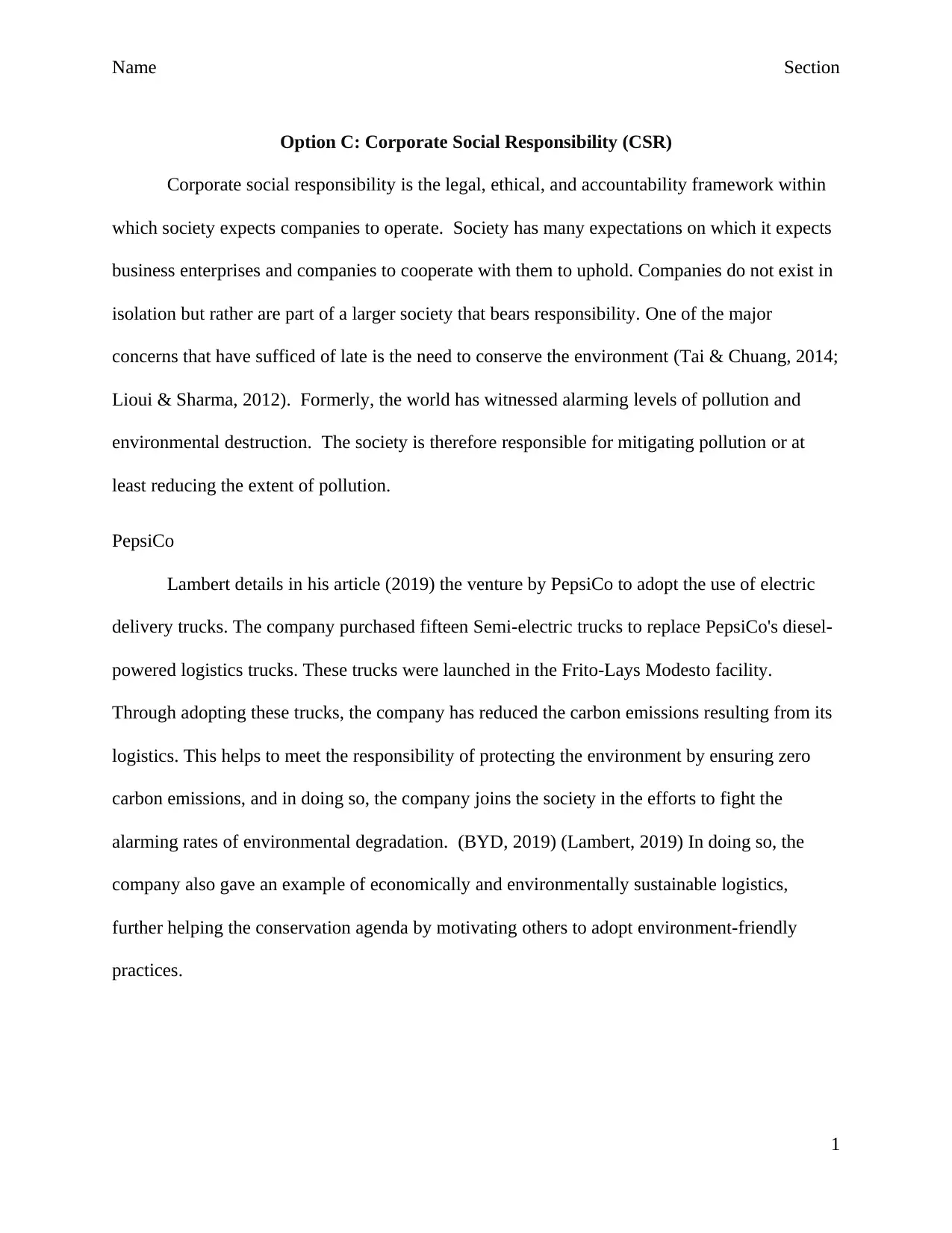
Name Section
Option C: Corporate Social Responsibility (CSR)
Corporate social responsibility is the legal, ethical, and accountability framework within
which society expects companies to operate. Society has many expectations on which it expects
business enterprises and companies to cooperate with them to uphold. Companies do not exist in
isolation but rather are part of a larger society that bears responsibility. One of the major
concerns that have sufficed of late is the need to conserve the environment (Tai & Chuang, 2014;
Lioui & Sharma, 2012). Formerly, the world has witnessed alarming levels of pollution and
environmental destruction. The society is therefore responsible for mitigating pollution or at
least reducing the extent of pollution.
PepsiCo
Lambert details in his article (2019) the venture by PepsiCo to adopt the use of electric
delivery trucks. The company purchased fifteen Semi-electric trucks to replace PepsiCo's diesel-
powered logistics trucks. These trucks were launched in the Frito-Lays Modesto facility.
Through adopting these trucks, the company has reduced the carbon emissions resulting from its
logistics. This helps to meet the responsibility of protecting the environment by ensuring zero
carbon emissions, and in doing so, the company joins the society in the efforts to fight the
alarming rates of environmental degradation. (BYD, 2019) (Lambert, 2019) In doing so, the
company also gave an example of economically and environmentally sustainable logistics,
further helping the conservation agenda by motivating others to adopt environment-friendly
practices.
1
Option C: Corporate Social Responsibility (CSR)
Corporate social responsibility is the legal, ethical, and accountability framework within
which society expects companies to operate. Society has many expectations on which it expects
business enterprises and companies to cooperate with them to uphold. Companies do not exist in
isolation but rather are part of a larger society that bears responsibility. One of the major
concerns that have sufficed of late is the need to conserve the environment (Tai & Chuang, 2014;
Lioui & Sharma, 2012). Formerly, the world has witnessed alarming levels of pollution and
environmental destruction. The society is therefore responsible for mitigating pollution or at
least reducing the extent of pollution.
PepsiCo
Lambert details in his article (2019) the venture by PepsiCo to adopt the use of electric
delivery trucks. The company purchased fifteen Semi-electric trucks to replace PepsiCo's diesel-
powered logistics trucks. These trucks were launched in the Frito-Lays Modesto facility.
Through adopting these trucks, the company has reduced the carbon emissions resulting from its
logistics. This helps to meet the responsibility of protecting the environment by ensuring zero
carbon emissions, and in doing so, the company joins the society in the efforts to fight the
alarming rates of environmental degradation. (BYD, 2019) (Lambert, 2019) In doing so, the
company also gave an example of economically and environmentally sustainable logistics,
further helping the conservation agenda by motivating others to adopt environment-friendly
practices.
1
Paraphrase This Document
Need a fresh take? Get an instant paraphrase of this document with our AI Paraphraser
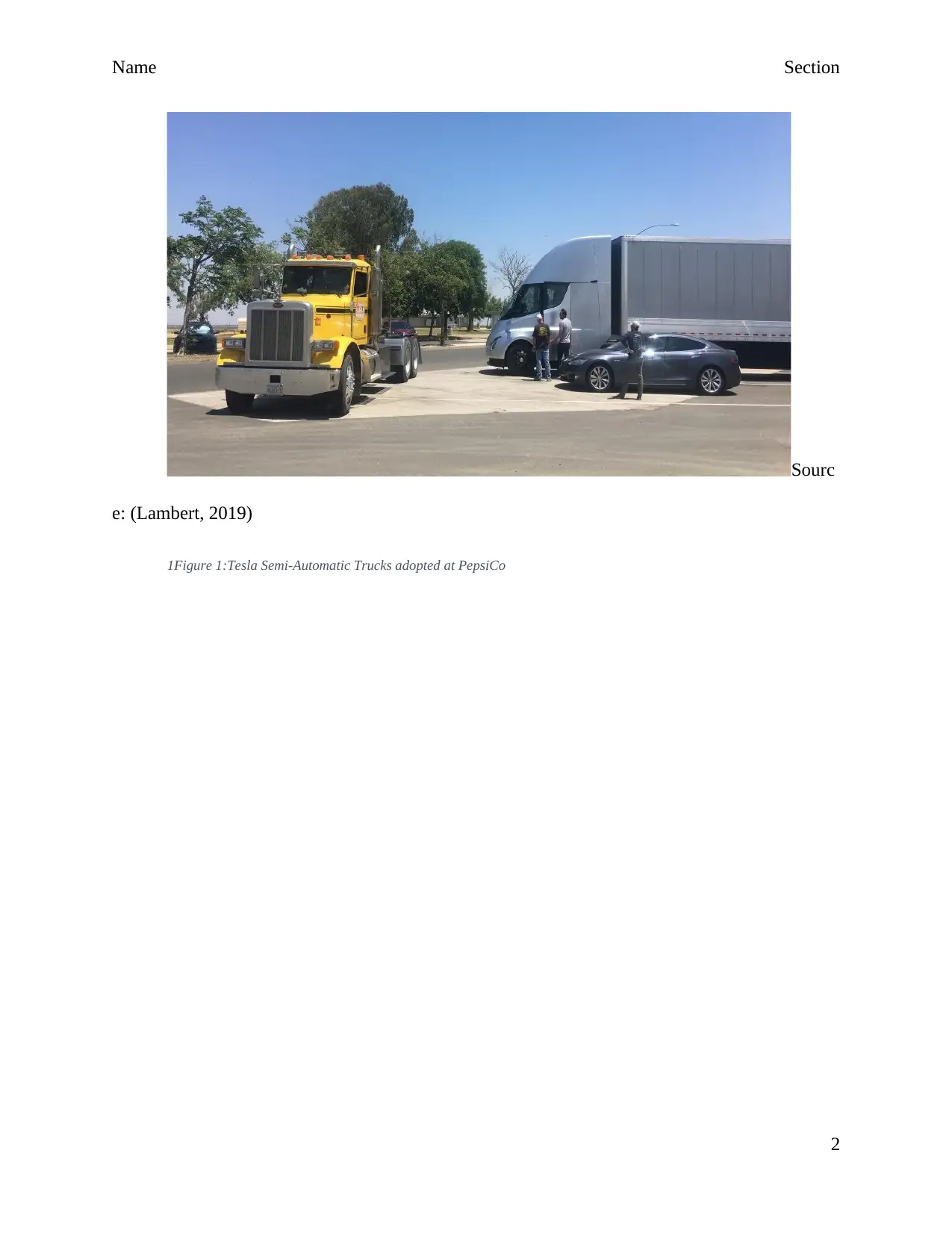
Name Section
Sourc
e: (Lambert, 2019)
1Figure 1:Tesla Semi-Automatic Trucks adopted at PepsiCo
2
Sourc
e: (Lambert, 2019)
1Figure 1:Tesla Semi-Automatic Trucks adopted at PepsiCo
2
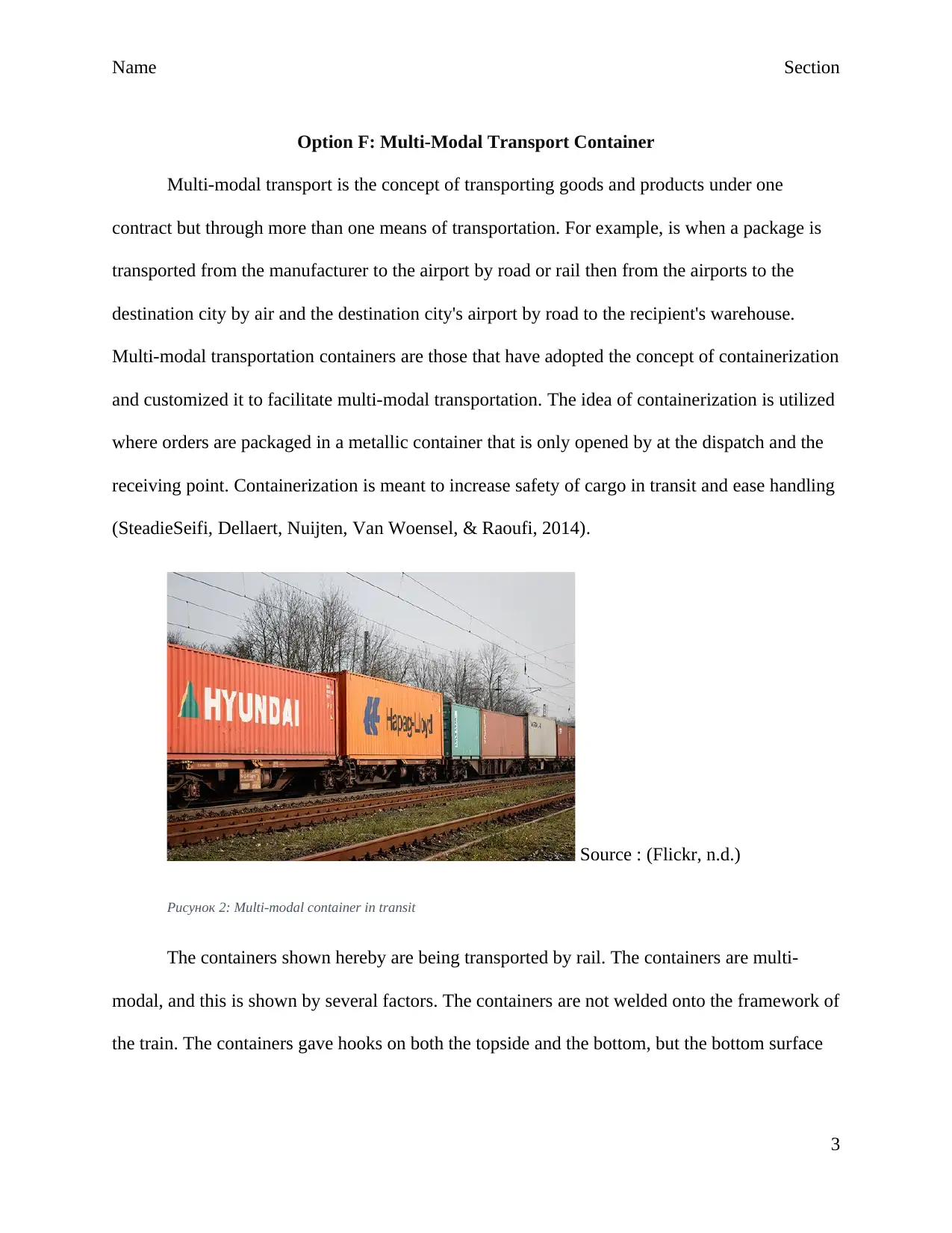
Name Section
Option F: Multi-Modal Transport Container
Multi-modal transport is the concept of transporting goods and products under one
contract but through more than one means of transportation. For example, is when a package is
transported from the manufacturer to the airport by road or rail then from the airports to the
destination city by air and the destination city's airport by road to the recipient's warehouse.
Multi-modal transportation containers are those that have adopted the concept of containerization
and customized it to facilitate multi-modal transportation. The idea of containerization is utilized
where orders are packaged in a metallic container that is only opened by at the dispatch and the
receiving point. Containerization is meant to increase safety of cargo in transit and ease handling
(SteadieSeifi, Dellaert, Nuijten, Van Woensel, & Raoufi, 2014).
Source : (Flickr, n.d.)
Рисунок 2: Multi-modal container in transit
The containers shown hereby are being transported by rail. The containers are multi-
modal, and this is shown by several factors. The containers are not welded onto the framework of
the train. The containers gave hooks on both the topside and the bottom, but the bottom surface
3
Option F: Multi-Modal Transport Container
Multi-modal transport is the concept of transporting goods and products under one
contract but through more than one means of transportation. For example, is when a package is
transported from the manufacturer to the airport by road or rail then from the airports to the
destination city by air and the destination city's airport by road to the recipient's warehouse.
Multi-modal transportation containers are those that have adopted the concept of containerization
and customized it to facilitate multi-modal transportation. The idea of containerization is utilized
where orders are packaged in a metallic container that is only opened by at the dispatch and the
receiving point. Containerization is meant to increase safety of cargo in transit and ease handling
(SteadieSeifi, Dellaert, Nuijten, Van Woensel, & Raoufi, 2014).
Source : (Flickr, n.d.)
Рисунок 2: Multi-modal container in transit
The containers shown hereby are being transported by rail. The containers are multi-
modal, and this is shown by several factors. The containers are not welded onto the framework of
the train. The containers gave hooks on both the topside and the bottom, but the bottom surface
3
⊘ This is a preview!⊘
Do you want full access?
Subscribe today to unlock all pages.

Trusted by 1+ million students worldwide
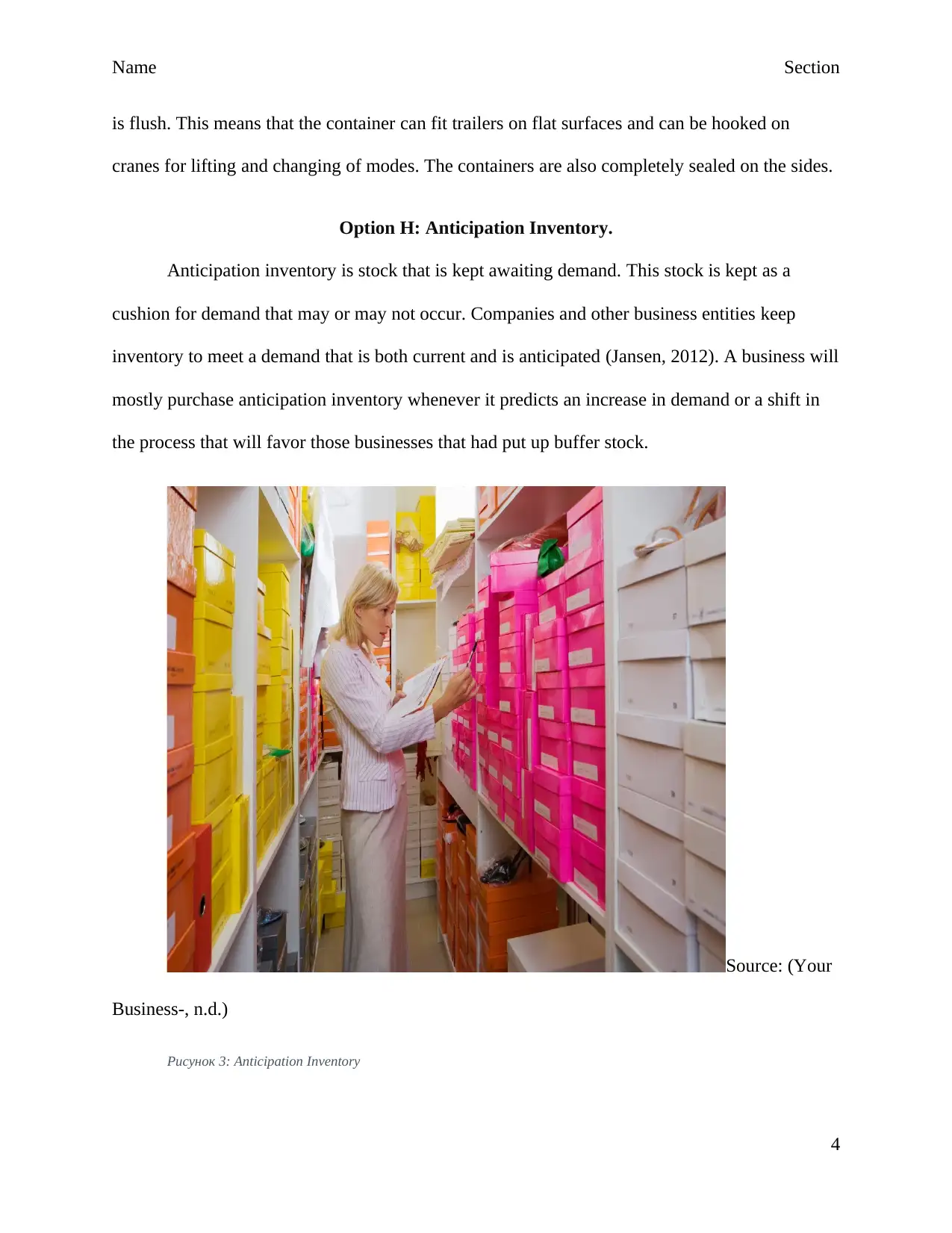
Name Section
is flush. This means that the container can fit trailers on flat surfaces and can be hooked on
cranes for lifting and changing of modes. The containers are also completely sealed on the sides.
Option H: Anticipation Inventory.
Anticipation inventory is stock that is kept awaiting demand. This stock is kept as a
cushion for demand that may or may not occur. Companies and other business entities keep
inventory to meet a demand that is both current and is anticipated (Jansen, 2012). A business will
mostly purchase anticipation inventory whenever it predicts an increase in demand or a shift in
the process that will favor those businesses that had put up buffer stock.
Source: (Your
Business-, n.d.)
Рисунок 3: Anticipation Inventory
4
is flush. This means that the container can fit trailers on flat surfaces and can be hooked on
cranes for lifting and changing of modes. The containers are also completely sealed on the sides.
Option H: Anticipation Inventory.
Anticipation inventory is stock that is kept awaiting demand. This stock is kept as a
cushion for demand that may or may not occur. Companies and other business entities keep
inventory to meet a demand that is both current and is anticipated (Jansen, 2012). A business will
mostly purchase anticipation inventory whenever it predicts an increase in demand or a shift in
the process that will favor those businesses that had put up buffer stock.
Source: (Your
Business-, n.d.)
Рисунок 3: Anticipation Inventory
4
Paraphrase This Document
Need a fresh take? Get an instant paraphrase of this document with our AI Paraphraser
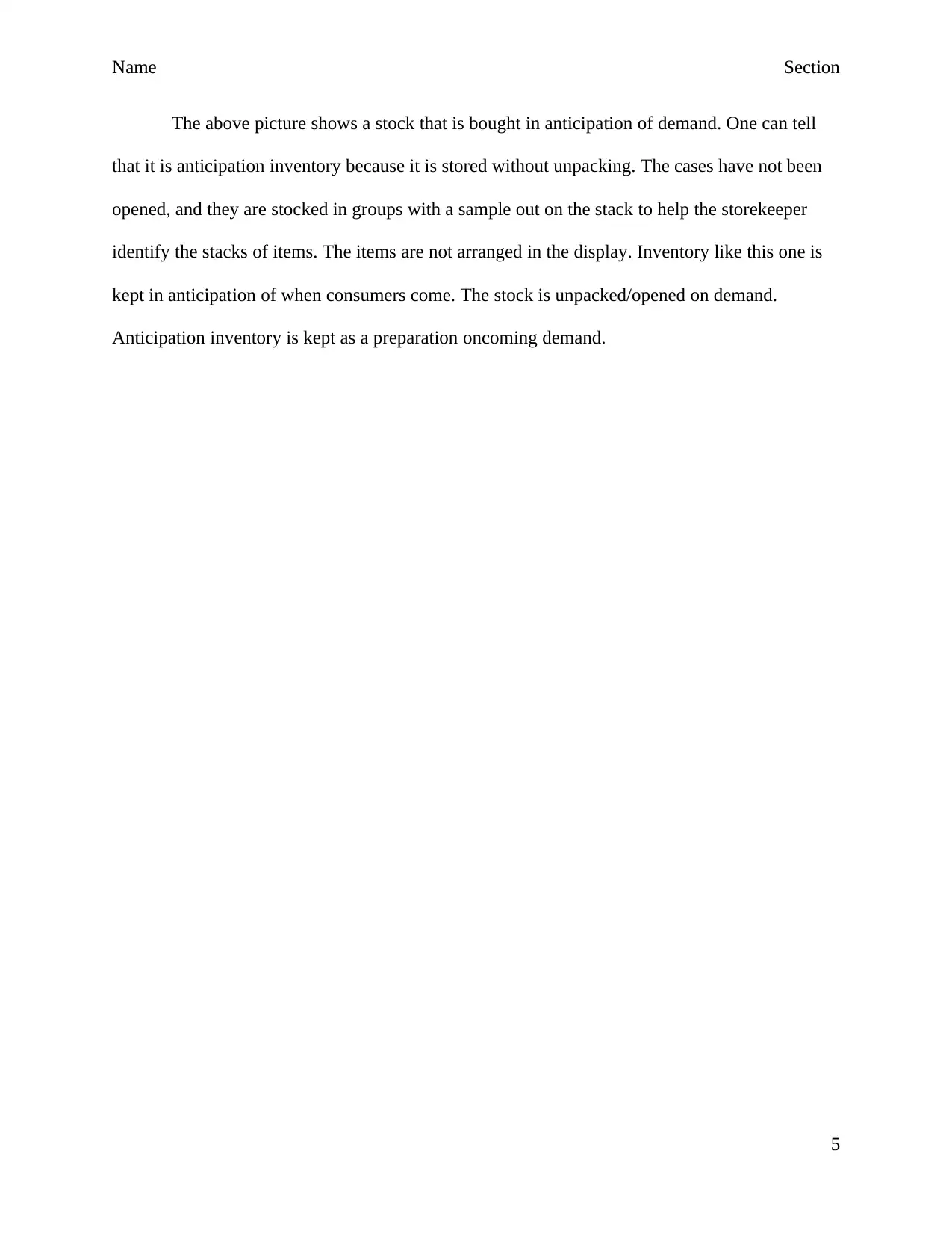
Name Section
The above picture shows a stock that is bought in anticipation of demand. One can tell
that it is anticipation inventory because it is stored without unpacking. The cases have not been
opened, and they are stocked in groups with a sample out on the stack to help the storekeeper
identify the stacks of items. The items are not arranged in the display. Inventory like this one is
kept in anticipation of when consumers come. The stock is unpacked/opened on demand.
Anticipation inventory is kept as a preparation oncoming demand.
5
The above picture shows a stock that is bought in anticipation of demand. One can tell
that it is anticipation inventory because it is stored without unpacking. The cases have not been
opened, and they are stocked in groups with a sample out on the stack to help the storekeeper
identify the stacks of items. The items are not arranged in the display. Inventory like this one is
kept in anticipation of when consumers come. The stock is unpacked/opened on demand.
Anticipation inventory is kept as a preparation oncoming demand.
5
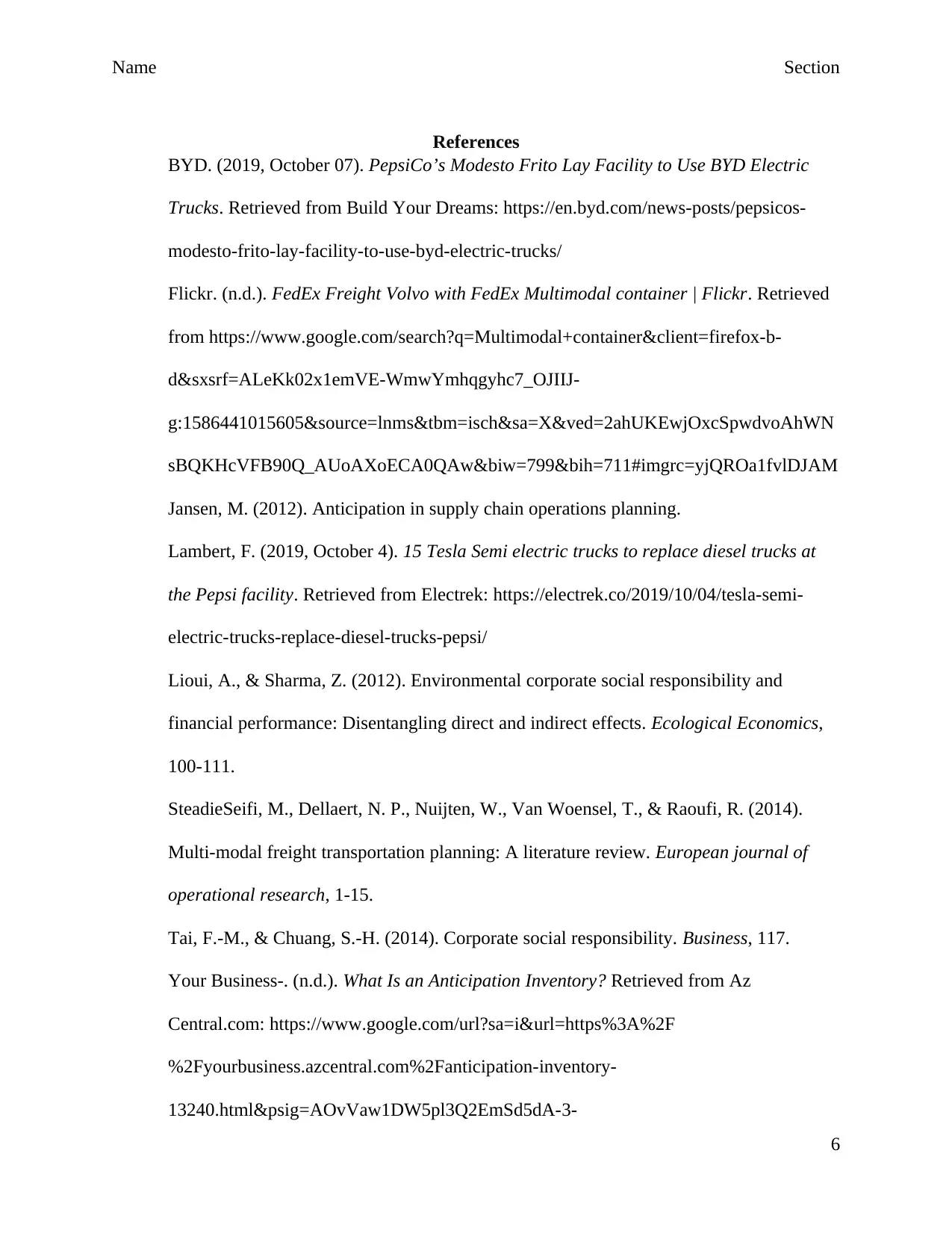
Name Section
References
BYD. (2019, October 07). PepsiCo’s Modesto Frito Lay Facility to Use BYD Electric
Trucks. Retrieved from Build Your Dreams: https://en.byd.com/news-posts/pepsicos-
modesto-frito-lay-facility-to-use-byd-electric-trucks/
Flickr. (n.d.). FedEx Freight Volvo with FedEx Multimodal container | Flickr. Retrieved
from https://www.google.com/search?q=Multimodal+container&client=firefox-b-
d&sxsrf=ALeKk02x1emVE-WmwYmhqgyhc7_OJIIJ-
g:1586441015605&source=lnms&tbm=isch&sa=X&ved=2ahUKEwjOxcSpwdvoAhWN
sBQKHcVFB90Q_AUoAXoECA0QAw&biw=799&bih=711#imgrc=yjQROa1fvlDJAM
Jansen, M. (2012). Anticipation in supply chain operations planning.
Lambert, F. (2019, October 4). 15 Tesla Semi electric trucks to replace diesel trucks at
the Pepsi facility. Retrieved from Electrek: https://electrek.co/2019/10/04/tesla-semi-
electric-trucks-replace-diesel-trucks-pepsi/
Lioui, A., & Sharma, Z. (2012). Environmental corporate social responsibility and
financial performance: Disentangling direct and indirect effects. Ecological Economics,
100-111.
SteadieSeifi, M., Dellaert, N. P., Nuijten, W., Van Woensel, T., & Raoufi, R. (2014).
Multi-modal freight transportation planning: A literature review. European journal of
operational research, 1-15.
Tai, F.-M., & Chuang, S.-H. (2014). Corporate social responsibility. Business, 117.
Your Business-. (n.d.). What Is an Anticipation Inventory? Retrieved from Az
Central.com: https://www.google.com/url?sa=i&url=https%3A%2F
%2Fyourbusiness.azcentral.com%2Fanticipation-inventory-
13240.html&psig=AOvVaw1DW5pl3Q2EmSd5dA-3-
6
References
BYD. (2019, October 07). PepsiCo’s Modesto Frito Lay Facility to Use BYD Electric
Trucks. Retrieved from Build Your Dreams: https://en.byd.com/news-posts/pepsicos-
modesto-frito-lay-facility-to-use-byd-electric-trucks/
Flickr. (n.d.). FedEx Freight Volvo with FedEx Multimodal container | Flickr. Retrieved
from https://www.google.com/search?q=Multimodal+container&client=firefox-b-
d&sxsrf=ALeKk02x1emVE-WmwYmhqgyhc7_OJIIJ-
g:1586441015605&source=lnms&tbm=isch&sa=X&ved=2ahUKEwjOxcSpwdvoAhWN
sBQKHcVFB90Q_AUoAXoECA0QAw&biw=799&bih=711#imgrc=yjQROa1fvlDJAM
Jansen, M. (2012). Anticipation in supply chain operations planning.
Lambert, F. (2019, October 4). 15 Tesla Semi electric trucks to replace diesel trucks at
the Pepsi facility. Retrieved from Electrek: https://electrek.co/2019/10/04/tesla-semi-
electric-trucks-replace-diesel-trucks-pepsi/
Lioui, A., & Sharma, Z. (2012). Environmental corporate social responsibility and
financial performance: Disentangling direct and indirect effects. Ecological Economics,
100-111.
SteadieSeifi, M., Dellaert, N. P., Nuijten, W., Van Woensel, T., & Raoufi, R. (2014).
Multi-modal freight transportation planning: A literature review. European journal of
operational research, 1-15.
Tai, F.-M., & Chuang, S.-H. (2014). Corporate social responsibility. Business, 117.
Your Business-. (n.d.). What Is an Anticipation Inventory? Retrieved from Az
Central.com: https://www.google.com/url?sa=i&url=https%3A%2F
%2Fyourbusiness.azcentral.com%2Fanticipation-inventory-
13240.html&psig=AOvVaw1DW5pl3Q2EmSd5dA-3-
6
⊘ This is a preview!⊘
Do you want full access?
Subscribe today to unlock all pages.

Trusted by 1+ million students worldwide

Name Section
V1A&ust=1586529654908000&source=images&cd=vfe&ved=0CA0QjhxqFwoTCKiQz
uHJ2-gCFQAAAAAdAAAAABAD
7
V1A&ust=1586529654908000&source=images&cd=vfe&ved=0CA0QjhxqFwoTCKiQz
uHJ2-gCFQAAAAAdAAAAABAD
7
1 out of 7
Your All-in-One AI-Powered Toolkit for Academic Success.
+13062052269
info@desklib.com
Available 24*7 on WhatsApp / Email
![[object Object]](/_next/static/media/star-bottom.7253800d.svg)
Unlock your academic potential
Copyright © 2020–2025 A2Z Services. All Rights Reserved. Developed and managed by ZUCOL.